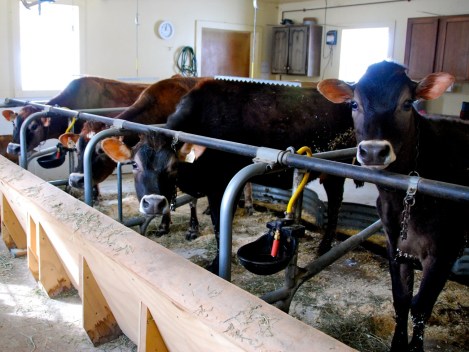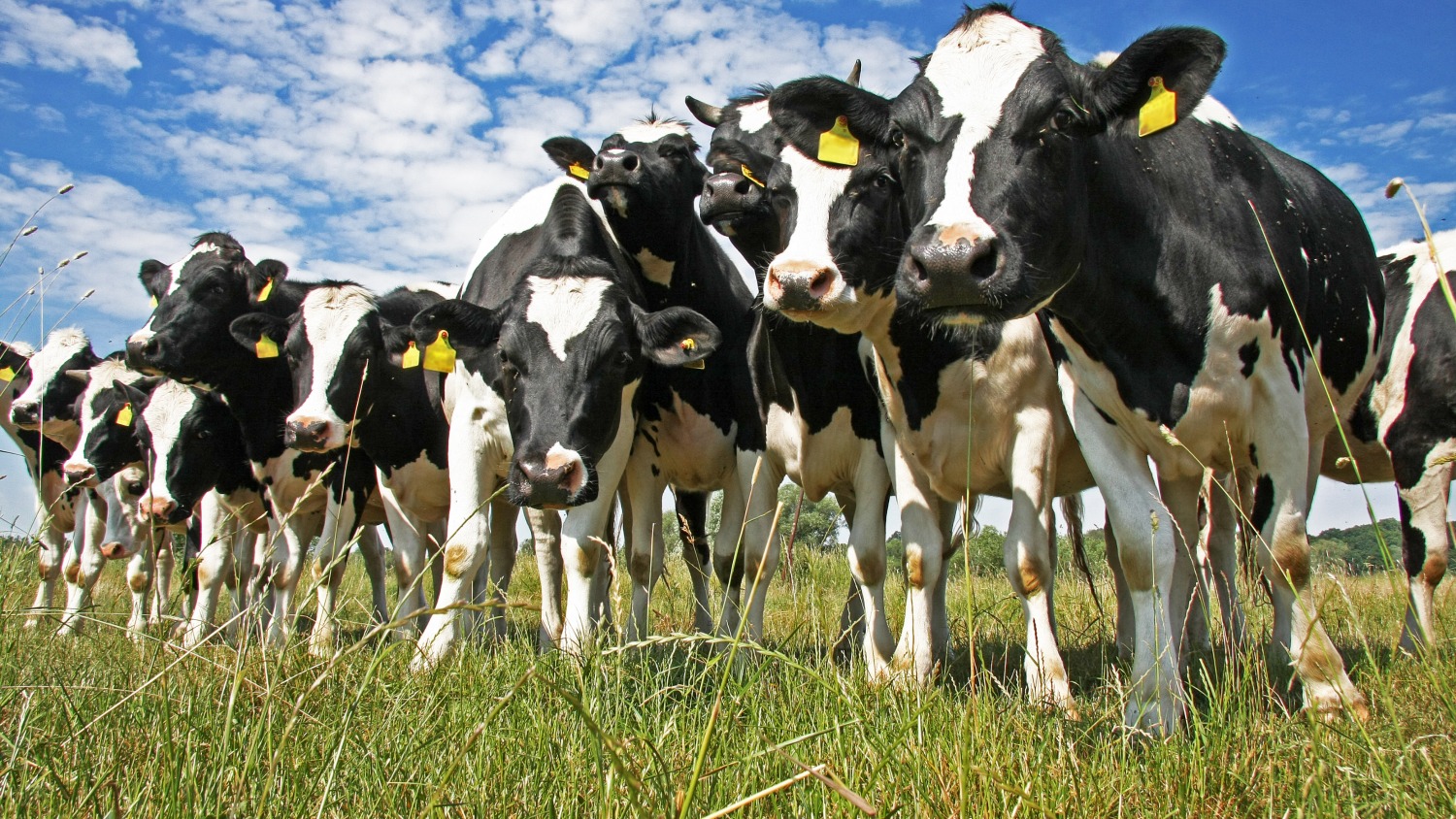It was after 6 p.m. and approaching 0 degrees Fahrenheit on a March evening when Doug Turner started the second milking of the day of his 42 cows at the family farm in Waitsfield, Vt. In a work-worn orange hoodie and flannel-lined jeans, the third-generation farmer started from the southeast corner of the barn, attaching one of his three milking machines to the swollen udder of a black and white cow.
“This one’s my oldest,” Turner told me, patting Bianca, a Holstein approaching her 13th birthday.
The milk flowed out of the barn, through a steel hose, to the tank in Turner’s cramped, old-fashioned milk house. Every other day, a milk truck from Organic Valley picks up this dairy and brings it to a processing facility — the closest ones are in Connecticut or New York — where it is pasteurized, homogenized, packaged, and dispatched to the grocery shelf.
All told, the average American gallon of milk travels 320 miles from udder to grocery store shelf, a journey that often crosses state borders. That seems like a long way to go, given that milk is produced in all 50 states.
But farmers don’t have much control over where their milk goes, or how much they get for it. If Turner can’t get by on what Organic Valley will pay him, he’s short on options. Striking out on his own, and setting his own price, would mean massive costs of starting his own processing plant. Now, new developments in micro-pasteurization from a Vermont company could change that.
Many of the farms that were here when I grew up in central Vermont have closed now, and much of the milk produced by the remaining few goes straight out of state. I set out to look at this technology to see if it could be the key to cutting down on dairy miles and saving small farms.
The LiLi pasteurizer — short for “Low Input – Low Impact” — is the first of its kind. Small-scale pasteurizers have long been available in the form of vats, essentially cauldrons that heat milk to at least 145 degrees F for 30 minutes. But the LiLi is a small-scale High Temperature Short Time (HTST) pasteurizer, which holds milk at 161 degrees for 15 seconds. It’s the first one to get FDA approval.
HTST makes for a quicker, more energy efficient pasteurizing process. According to Steve Judge, the founder of Bobwhite Systems and the man behind the LiLi, it also makes for better milk.
“The idea was to pasteurize the milk and have it be as much like raw milk as possible,” Judge said.

Jana Koschak, the dairy and food lab technician at Bobwhite Systems, demonstrates the LiLi.
It took seven years and three models, but Judge and his colleagues finally found the winning formula. The LiLi, which is about the size of a refrigerator, went on sale after FDA approval last November. It costs about $70,000, which may seem like a lot, but it’s nothing compared to the alternative of building a creamery, which can easily amount to a million dollars or more.
Back in 2006, Judge, a 45-year veteran of the dairy industry, wanted to offer the community the chance to buy milk from the four Jerseys in his hobby barn in Royalton, Vt. He could sell raw milk from his farm, but he wanted the option of selling pasteurized as well. Looking around, he found no technology that would suit his needs and meet US regulations, so he set about creating it.
The LiLi, however, is not just an answer to Judge’s personal needs. It fits into a vision Judge has of how dairy farming should operate. Through nearly half a century in the dairy industry that took him from owning a herd of 90 Jerseys to managing a water buffalo farm, he watched the modus operandi of dairy evolve. Big herds got bigger, small farms either expanded or went under.
According to Progressive Dairyman, the national average herd size grew from 123 to 196 between 2002 and 2013. In 2011, herds of 100 or more cows made up less than a third of the industry, but accounted for 86.4 percent of all milk production.
“I really don’t like the idea of having dairy be industrialized like chicken or pork,” Judge said. “I think it’s a really important part of our cultural heritage.”

Judge’s Jersey cows.
That’s when he began considering methods to eliminate the middleman and connect farms directly to their consumers. If milk could be pasteurized onsite, it could skip the processing plant altogether. Instead of selling to big companies run from halfway across the country, farmers could sell directly to the buyer.
“It’s better milk for the consumer, it’s a better way to treat the cows, it’s good for the community,” Judge said.
When Turner started milking cows at age 15, many of his neighbors milked cows as well.
Now, at 59, he’s feeling lonely.
Challenges started mounting for family dairies, like high feed costs and low milk prices. Conventional dairies were faced with expanding to make ends meet, or finding a different edge. One of Turner’s neighbors switched over to beef cattle. Two others gave up all together.
“All of a sudden I’m the only one down here,” Turner said.
Facing the pressures himself, Turner picked option No. 3: He maintained his size and went organic. Organic dairy farming complicates everything. It stipulates specific practices relating to grazing, feed, medical treatments — but it also pays better.
“It was getting very hard for the farm to survive with the highs and the lows and the pricing. This offered a steady income,” said Turner. “The cows are definitely healthier.”
Six years on, the pressure has not relented. Feed prices have continued to rise, requisite organic products are a big expense, and natural disasters like 2011’s Hurricane Irene have delivered hefty bills and a mountain of paperwork. But the payout for organic milk hasn’t gone up to match expenses.
These days, Turner makes about $2.60 per gallon sold to Organic Valley. He makes nearly twice that selling raw milk off the farm at $5 a gallon.
So, could Turner benefit from leaving the Organic Valley network and going it alone with a LiLi?
Bob Parsons, an agriculture economy specialist at the University of Vermont is not convinced.
“It’s not just the pasteurizer,” said Parsons. “You have to find a market for your milk.”
Parsons emphasized that pasteurization is just one step in a long process getting milk from cows, into bottles, and to the stores that will sell it.
“You’re running a retail business and all of a sudden you’re not a dairy farmer anymore.”
Besides, he notes, Vermonters only consume 15 percent of the milk produced in the state. The rest goes out to other markets. More than 70 percent of Vermont’s total farm dollars come from dairy.
For some dairy farmers with an entrepreneurial streak, the chance to sell their milk directly to their neighbors could be enticing. But for a multi-generation farmer like Turner, already putting in 15-hour days, onsite pasteurization is an extra layer of work.
“Most people doing dairy farming do it because they like the dairy farming,” Parsons said.
In fact, the value of the small-scale HTST pasteurizer may not be in cutting out the middleman between dairy farmers and consumers, but in creating a new kind of middleman. With its hefty price tag — beyond the reach of cash-strapped, leveraged-out family farms — the LiLi could be best suited for a local dairy co-op, or an entrepreneur looking to process at a community level.
Judge recognizes that the LiLi might not be the answer to everybody’s problems. But, he notes, there are plenty of people who’d consider it. Bobwhite Systems has sold one of the $70,000 pasteurizers to an upstate New York farm, and is in negotiations with a Vermont farmer to place the second. They’re marketing the LiLi beyond the barnyard as well, looking to people who buy milk to produce other things, like yogurt or cheese.
“We’re not out there trying to sell them to everybody, but we know based on the response so far that there is interest,” Judge said.
“For me, the issue is a matter of locally produced milk from sustainable farms versus commercially produced milk from factory farms.”



